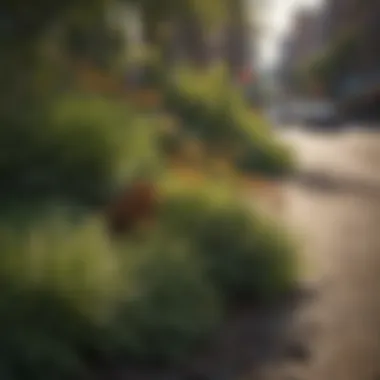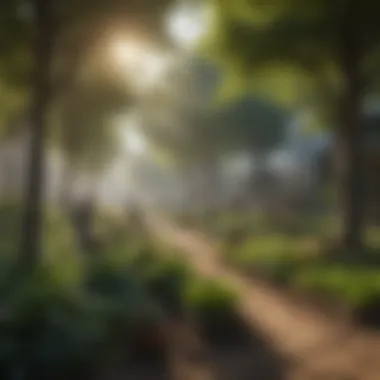Exploring Urban Leaf: Nature's Role in Cities


Intro
Urban environments often lack the green spaces that contribute to the health and well-being of their inhabitants. The urban leaf concept presents an opportunity to blend nature with city life, creating a synergy that benefits both the environment and urban residents. By examining the biological, ecological, and social significance of integrating greenery into dense urban landscapes, this article aims to highlight the necessity of urban greening initiatives.
This exploration includes a review of suitable plant species for urban settings, the ecological benefits of urban greening, potential challenges that may arise, and strategies for enhancing urban biodiversity. A comprehensive understanding of these aspects is essential for forestry professionals and academics who seek to amplify the role greenery plays in contemporary urban planning.
Understanding Woodland Ecosystems
Urban landscapes frequently imitate and manipulate natural ecosystems. However, understanding the foundation of these ecosystems is crucial. Woodland ecosystems comprise diverse plant species, interconnected life forms, and intricate soil systems. Their complexity fosters biodiversity that is essential for ecological stability.
Importance of Biodiversity in Forests
Biodiversity in forests is pivotal in sustaining ecological balance. Various plant and animal species interact in a woodlands, forming a network where each component plays a role in nutrient cycling, pollination, and habitat provision. By maintaining this diversity, forests can adapt more readily to environmental changes.
Urban areas can learn from these principles. Integrating a variety of vegetation species into urban planning not only supports ecological resilience but also allows cities to adapt to climate fluctuations.
Role of Forests in Climate Regulation
Forests act as critical regulators of local climate. They help moderate temperatures, control humidity, and contribute to rainfall patterns. Urban leaf strategies can mimic these benefits through large-scale planting efforts. By introducing trees and greenery into urban settings, cities can foster cooler microclimates, reduce heat islands, and trap pollutants.
"Integrating greenery into urban planning is not just an aesthetic choice; it’s a necessary strategy for sustainability."
Sustainable Forestry Practices
Sustainable forestry practices lay the groundwork for maintaining healthy urban ecosystems. These practices encourage the responsible management of forest resources while promoting biodiversity.
Principles of Sustainable Forestry
The core principles of sustainable forestry include:
- Maintaining biodiversity by protecting various plant species
- Minimizing environmental impact during logging and construction
- Restoring degraded land
- Engaging local communities in conservation efforts
Cities can adopt these principles when planning urban green spaces.
Case Studies of Successful Implementations
Examples from various cities demonstrate the effectiveness of sustainable forestry practices. Cities like Singapore and Amsterdam have successfully integrated greenery into their urban designs through innovative planning and community engagement. These examples serve as insights into the viability of urban greening strategies.
Woodland Stewardship Techniques
Managing urban foliage requires dedicated stewardship techniques that ensure long-term health and sustainability of these green spaces.
Forest Management Plans
Creating comprehensive forest management plans involves assessing existing resources, setting clear goals, and implementing techniques that promote biodiversity. These plans must be adaptable to changing urban conditions and strive for a continuous improvement cycle.
Conservation Strategies
Conservation strategies are vital in preserving urban biodiversity. This includes protecting existing green spaces, restoring native plant communities, and minimizing the impact of invasive species. Engaging with residents and fostering a community ethic of stewardship can further enhance these efforts.
By focusing on these elements, urban planners and green space advocates can make meaningful progress toward harmonious coexistence between nature and urbanization.
Understanding Urban Leaf


The concept of Urban Leaf is pivotal in the discussion of how greenery can coexist with urban life. This section aims to elucidate the term and its significance in contemporary urban planning. Integrating nature into cityscapes is not merely an aesthetic choice; it serves as a vital element for the health of urban ecosystems. Understanding Urban Leaf means recognizing the essential role of greenery in enhancing both environmental quality and community vitality.
Definition and Relevance
Urban Leaf refers to the incorporation of vegetative elements within urban settings. This concept encompasses parks, gardens, green roofs, and other forms of greenery that play a crucial role in urban sustainability. Its relevance is underscored by the increasing urbanization trend, where more than half of the world's population now resides in cities, a figure projected to rise. Integrating greenery into these densely populated regions improves air quality, enhances aesthetic value, and fosters biodiversity. Importantly, urban leaf initiatives can also enhance mental health by providing residents with accessible nature experiences.
Historical Context
The historical context of Urban Leaf is essential for understanding its current relevance. For centuries, cities have been designed primarily for functionality, often at the expense of natural elements. However, as urbanization intensified, the detrimental effects of this approach became apparent. The Industrial Revolution marked a turning point, as it brought pollution and health issues, increasing awareness of the need for green spaces. As a response, early urban planners began advocating for parks and tree planting.
In the late 20th century, cities like New York and Paris began reimagining their landscapes by creating urban forests and green corridors. These initiatives were driven by both aesthetic sensibilities and a recognition of the ecological benefits that urban greenery can provide. This historical evolution highlights a significant shift in urban design philosophy, where today, integrating nature into urban planning is seen not only as a benefit but also a necessity. As we confront climate change, understanding Urban Leaf gains even greater urgency.
The Ecological Importance of Urban Greenery
Urban greenery holds profound significance in the ecological landscape of cities. It bridges the gap between the natural environment and human habitation, providing various ecological benefits that extend beyond aesthetic value. The increase in urban population and subsequent urbanization has made it essential to recognize and enhance the ecological contributions of urban foliage. Green spaces are not mere luxuries; they are pivotal in promoting environmental sustainability, improving community resilience, and enriching urban biodiversity.
Biodiversity in Urban Areas
Urban areas often struggle with a lack of biodiversity due to extensive land coverage by buildings and infrastructure. However, every opportunity to include green spaces can introduce new plant and animal species. Cities can support a surprising variety of organisms ranging from birds to insects.
Encouraging native species in urban landscapes can promote local ecosystems and provide habitats for wildlife. The implementation of managed green areas, such as parks, community gardens, and green roofs, helps bolster these efforts. A higher biodiversity index leads to improved resilience against environmental changes, pest outbreaks, and diseases. Moreover, it enhances the quality of life for residents. Such spaces become vital nodes in ecological networks connecting urban areas to surrounding natural habitats.
Ecosystem Services Provided by Urban Foliage
Urban greenery delivers multiple ecosystem services that are essential for maintaining ecological balance and promoting health in urban environments. These services include:
Air Quality Improvement
Air quality is a pressing issue in many urban areas. Plants play a critical role by filtering pollutants from the air. They absorb carbon dioxide and release oxygen through photosynthesis, mitigating the effects of urban smog. The addition of trees and vegetation can significantly reduce airborne particles, thus improving respiratory health among residents.
The filtering process of urban foliage also reduces the concentration of harmful gases like sulfur dioxide and nitrogen oxides. The presence of greenery fosters healthier urban living environments, making Air Quality Improvement a key objective for urban planners.
Urban Heat Island Mitigation
Urban Heat Island effect is a phenomenon where urban areas become significantly warmer than their rural surroundings. This results from extensive concrete surfaces and limited vegetation. Urban greenery is an effective solution, as it cools the surrounding environment through shade and the evaporation of water.
Charcteristically, cities with adequate urban foliage often experience lower temperatures during hot weather. As a result, Urban Heat Island Mitigation reduces the overall energy consumption for cooling and enhances comfort for residents. However, it also necessitates strategic planning to maximize its effectiveness in different urban landscapes.
Water Management
Water management in urban areas requires innovative approaches due to high levels of impervious surfaces leading to flooding and runoff issues. Urban greenery aids in water absorption by increasing soil permeability. Plants and trees promote natural water filtration and reduce stormwater runoff, thereby protecting water quality.
Furthermore, the implementation of sustainable features such as rain gardens and permeable pavements improves rainwater management. With effective Water Management strategies, flooding risks can be mitigated while also ensuring sustainable water use practices in urban settings.
The incorporation of greenery into urban settings not only enhances aesthetics but also fosters essential ecological benefits, creating healthier environments for communities.
Types of Plants for Urban Environments
The selection of plant species for urban areas carries both ecological significance and practical considerations. Urban environments present unique challenges due to their often harsh conditions, including limited space and exposure to pollution. Hence, the types of plants chosen for urban greening efforts are crucial for fostering sustainable and healthy urban ecosystems. It is essential to focus on native versus non-native species, resilient plant varieties, and innovative solutions such as vertical gardens and green roofs. These components work together to ensure urban greenery thrives and serves its intended purpose.
Native versus Non-Native Species
Native plants are those that naturally occur in a given region, while non-native species are introduced from other areas. When selecting plants for urban landscapes, native species offer several advantages:


- Adaptation to Local Climate: Native plants are better adapted to local conditions, meaning they are more likely to thrive with minimal care.
- Support for Local Wildlife: They provide food and habitat for local fauna, such as birds, insects, and other wildlife, enhancing urban biodiversity.
- Less Resource Intensive: Native species generally require less water and fertilizer compared to non-native plants, making them more sustainable choices for cities facing resource constraints.
However, non-native species can also play a role. They may be utilized for ornamental purposes or to fill specific niches where native plants struggle. Yet, caution is necessary as some non-native species may become invasive, outcompeting local flora.
Selecting Resilient Plant Varieties
In urban settings, selecting resilient plant varieties is paramount. These plants withstand urban stressors like pollution, compacted soil, drought, and varying light conditions. Key characteristics to consider when choosing resilient plants include:
- Drought Tolerance: Plants like sedums and ornamental grasses can survive long periods without water, making them ideal for low-maintenance urban areas.
- Pollution Tolerance: Species such as silver birch or urban-tolerant varieties of maples can cope with air and soil pollution, contributing positively to urban air quality.
- Ability to Adapt to Compact Soil: Some trees and shrubs can adjust to the limited root space typical of city landscapes, offering structural stability and beauty.
Choosing these varieties not only supports the urban ecosystem but also yields long-term benefits, reducing the need for intensive care and maintenance.
Vertical Gardens and Green Roofs
Vertical gardens and green roofs represent innovative approaches to incorporate greenery into limited urban spaces. These systems are not just aesthetic improvements; they offer numerous environmental and social benefits, such as:
- Air Quality Enhancement: Plants in vertical gardens can filter air pollutants, leading to improved urban air quality.
- Temperature Regulation: Green roofs help mitigate the urban heat island effect by providing insulation, lowering temperatures in urban areas.
- Water Management: Both vertical gardens and green roofs assist in managing stormwater runoff, reducing flooding risks in cities.
Implementing these green structures requires thoughtful design and careful selection of appropriate plant species that can thrive in these unique environments.
In sum, the types of plants selected for urban environments should reflect a balance between local ecology and the functional demands of urban life. The emphasis on native species, resilient plant varieties, and innovative greening solutions can lead to a healthier and more sustainable urban future.
Designing Urban Green Spaces
Designing urban green spaces is a crucial aspect of creating livable cities. This involves integrating nature into urban planning to enhance the quality of life for residents. Green spaces can offer numerous benefits, including improved air quality, increased biodiversity, and enhanced community cohesion.
Principles of Urban Landscaping
Effective urban landscaping relies on several key principles. Firstly, understanding the local ecosystem is essential. This includes knowing the native plant species and their interactions with urban wildlife. Additionally, sustainable design practices should be prioritized. This can include utilizing native plants, reducing water usage through xeriscaping, and creating habitats to support local wildlife.
Moreover, accessibility plays a significant role. Green spaces should be easy to reach for all community members, encouraging urban dwellers to use these areas for recreation and relaxation. Integrating pathways, seating, and shade through strategic planting helps create an inviting atmosphere. Lastly, multifunctional spaces are increasingly necessary. Parks and gardens that serve as community gathering spots, recreational areas, and educational resources can better meet diverse needs.
Community Involvement in Planning
Involving the community in the planning and design of green spaces is vital. Stakeholders such as residents, local businesses, and environmental groups can provide valuable input. When community voices are considered, the final design is more likely to reflect the needs and desires of those who will use the spaces.
Furthermore, community engagement can foster a sense of ownership. When locals contribute to the planning process, they tend to take better care of the space. Organizing workshops, surveys, and meetings allows for direct feedback, ensuring the facility meets the unique needs of the area.
Case Studies of Successful Urban Projects
Several urban projects exemplify successful green space design. One notable example is the High Line in New York City. This elevated linear park transformed an abandoned railway into a vibrant community space, integrating native plant species and public art. It has become a symbol of innovative urban greening and has boosted local economies.
Another impactful project is the Singapore Botanic Gardens. This UNESCO World Heritage site showcases the importance of preserving biodiversity in urban settings. Its emphasis on education, community involvement, and sustainability provides a model for other cities.
Overall, these case studies illustrate that well-designed green spaces can revitalize urban areas. They enhance community well-being, improve biodiversity, and showcase the potential of integrating nature within the fabric of urban life.
Challenges in Urban Greening
Urban greening faces several obstacles that can impede its potential to enrich city landscapes. Understanding these challenges is critical in devising effective strategies that can lead to more sustainable and vibrant urban environments. By acknowledging these issues, urban planners, community members, and environmental advocates can collaboratively seek solutions that enhance the integration of nature into urban spaces.
Environmental Factors
The environmental context within urban areas presents unique challenges that affect the health and viability of green spaces. For instance, urban heat islands can cause elevated temperatures, which may stress plants that are not heat-tolerant. Additionally, pollutants in the air and soil can hinder plant growth and diminish their ability to provide ecosystem services. Plant selection becomes crucial here; plants must not only adapt to urban conditions but also serve as effective tools in mitigating environmental stresses.


Here are some specific environmental factors affecting urban greening:
- Air Quality: Polluted air can damage foliage and impact the growth of certain species. Native plants often adapt better to local pollution.
- Water Availability: Urban water management can complicate irrigation. Drought-resistant plants like succulents are preferred in areas with limited water.
- Soil Quality: Soil contamination from urban activities can hinder plant growth. Soil testing and remediation may be necessary for successful plant establishment.
"Understanding environmental factors is key to ensuring the success of urban greenery initiatives. One must choose the right plants for the prevailing conditions."
Social and Economic Constraints
Besides environmental factors, social and economic issues often limit the scope and success of urban greening. Public funding for green projects may be limited or rely heavily on political goodwill. Therefore, active community involvement is essential. Without strong community support, initiatives may struggle or fail altogether. For instance, some neighborhoods with lower income may lack access to adequate resources to develop and maintain urban greenery.
Key considerations include:
- Budget Constraints: Limited funding can restrict complex projects like parks or green roofs. Simple, cost-effective solutions may need implementation first.
- Public Perception: Urban greening projects may need to be communicated effectively to gain support from the public. Engagement through social media platforms like Facebook or Reddit is vital here.
- Equity in Urban Development: It is essential to ensure that all communities, regardless of income, have equal access to green spaces. Addressing disparities is crucial for sustainability.
To summarize, urban greening faces multiple challenges that span both environmental and socio-economic realms. Addressing these challenges efficiently requires informed decisions, collaborative efforts, and a commitment to inclusivity in urban design.
Innovative Approaches to Urban Leaf Management
The management of urban greenery requires innovative approaches to ensure sustainability and effectiveness. Traditional methods often fail to address the unique challenges faced by urban landscapes. As cities grow, the integration of nature into urban planning becomes not just advantageous but essential. Innovative approaches can enhance biodiversity, improve air quality, and promote overall well-being among urban inhabitants.
These methods encompass a range of strategies that leverage technology, community engagement, and policy development. Understanding these innovations is critical for urban planners and environmental professionals, as they seek to balance ecological needs with urban development.
Technological Advancements
Technological advancements play a pivotal role in urban leaf management. Geographic Information Systems (GIS) are increasingly used for mapping urban green spaces, providing data on plant health and growth patterns. This technology allows for better planning and management decisions based on solid data.
Drones are another tool that has become popular. They can survey urban areas for vegetation health and monitor changes over time. Moreover, sensor technology is being deployed to collect real-time data on soil moisture, temperature, and air quality, facilitating responsive management to the pressing needs of urban landscapes.
Furthermore, apps and platforms that connect citizens with urban greening projects are gaining traction. These digital solutions foster community involvement by allowing citizens to report issues, volunteer for local projects, or access information about urban greenery news.
Policy Recommendations for Sustainable Practices
Policy is a critical framework for supporting innovative urban leaf management. Sustainable practices should be embedded in local government regulations to ensure lasting positive impacts.
One recommendation is to incentivize the planting of native species, which support local wildlife and require less maintenance. Local governments can also create guidelines that prioritize green infrastructure in both new developments and renovations. Another crucial area is funding; establishing grants for community-led greening projects can foster local stewardship and engagement.
Additionally, policies need to address equitable access to green spaces. Urban environments should develop inclusive approaches that ensure all communities have access to greenery, regardless of socioeconomic status. Collaborations between the public and private sectors can also support innovative urban leaf planners through resources and expertise.
"As cities evolve, the integration of nature into urban planning should reflect modern challenges and needs, supporting sustainable and equitable development."
By implementing these approaches, cities not only enhance their ecological footprint but also promote healthier living environments. The intertwined relationship between urban greening and community well-being cannot be overlooked. Thus, pursuing innovative methods is fundamental for future urban development.
The Future of Urban Leaf
The future of urban leaf is a critical focus for urban planners, environmentalists, and communities alike. As cities continue to expand, integrating nature into urban spaces becomes increasingly vital. This integration is not just about aesthetics but also concerns sustainability, climate resilience, and public health. Addressing these elements ensures that urban areas can cope with increasing populations and the associated pressures on infrastructure and the environment.
Emerging Trends in Urban Greening
Emerging trends in urban greening highlight innovative approaches to incorporating plants and green spaces into urban settings. One such trend is the use of technology in creating smart green infrastructure. For example, sensors can monitor soil moisture and plant health, informing maintenance decisions and improving survival rates for urban foliage.
Moreover, cities are looking towards climate-adaptive planting strategies. This means choosing plant species that can endure extreme weather conditions, such as heatwaves or heavy rainfall. Native plants are gaining popularity since they typically require less water and offer better support for local wildlife. Finally, fostering community gardens and urban farms is becoming more common, which promotes local food sourcing and strengthens community ties.
Collaborative Efforts for Better Landscapes
Collaborative efforts are essential for developing better landscapes that align with the goals of urban greening. Partnerships between local governments, non-profit organizations, and community groups can facilitate funding for green projects and increase public involvement. These collaborations can range from educational programs that teach urban gardening skills to larger initiatives focused on restoring degraded areas with native plantings.
Furthermore, engaging with local businesses for sponsorship can enhance resources available for urban greening projects. For instance, local companies might contribute funding or materials in exchange for promotional opportunities tied to these initiatives. An important facet of these collaborative efforts includes public input and community feedback. Open dialogues allow urban planners to understand the needs and desires of residents, which is crucial for designing spaces that people will use and value.
"The intersection of nature and urbanization is essential for fostering resilient communities that thrive in harmony with their environments."
This future focus on collaboration and innovation underlines the need for a multi-faceted approach to urban leaf management. Through engaging communities and leveraging technology, the potential for enhancing urban landscapes is significant. People will be encouraged to embrace greener living, ultimately contributing to more sustainable and vibrant urban ecosystems.







